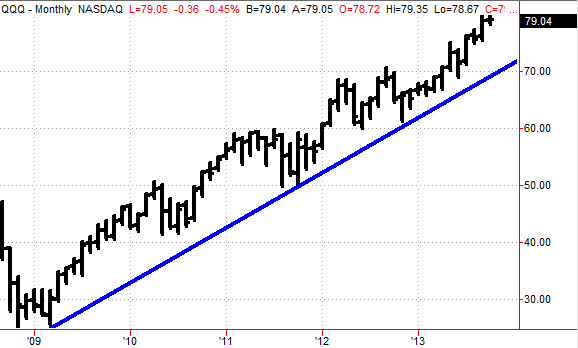
A trend trading system is specifically designed to trade with the trend. The system is comprised of a set of rules that will first identify the trend and then identify opportunities to enter trades in the direction of the trend. Trend trading systems are also referred to as trend following systems.
The chart above is a monthly chart of the QQQ. It shows a trend line drawn on the chart which helps us to further visualize the major trend. In this case it is quite obvious that the major trend is upward. As the major trend is upward, the trend trader would only want to take long trades.
Our QQQ chart above is just one example of a major trend. Although what we are looking at is a monthly chart, trends exist in all time frames. While trend trading is typically longer-term in nature, there are short-term traders who find success in trading only in the direction of the major trend. These traders would identify the major trend using a chart of a longer time frame and use that major trend as their frame of reference.
There are numerous ways to trade with the trend:
TrendLine Trading – In our QQQ chart above a very long-term trader may simply choose to stay long as long as the QQQ stays above the blue trendline.
A simple trendline trading system would buy and stay long as long as the prices or above and up trendline and sell and stay short as long as the prices were below a down trendline.
Moving Average Trading – Moving averages have long been used by traders seeking to trade with the trend. A typical moving average trading system uses moving averages to both enter and exit trades. Here’s a simple example of a few moving average system rules:
If the close of XYZ is greater than the moving average then buy XYZ
If the close of XYZ is less than the moving average then sell XYZ
Naturally, those are super-simplified rules created only for the purpose of illustration.
Multiple moving averages may also be used in order to trade with the trend. Here’s a simple example of a few moving average system rules using 2 different moving averages:
If moving average A is greater than moving average B then buy XYZ
If moving average A is less than moving average B then sell XYZ
This example is a bit different than our initial moving average example. One difference that you will immediately notice is that the trades are triggered without using the price levels of XYZ. The trades are triggered when one moving average moves above or below the other moving average. This particular type of system is known as a “moving average crossover” system. It is named as such because one moving average “crosses over” the other moving average. The moving average that crosses over, in our case moving average A, is known as the fast moving average. It is known as the fast moving average because it’s value changes faster than moving average B, which is known as the slow moving average.
The fast moving average is calculated on a smaller number of time periods than the slow moving average. For example, we may select a 10-period moving average as our fast moving average and a 50-period moving average as our slow moving average.
We have just covered a few examples of some basic trend trading systems. There are a wide variety of systems that can be used in trend following. They will include such systems as a channel breakout system and many, many more.
Speak Your Mind